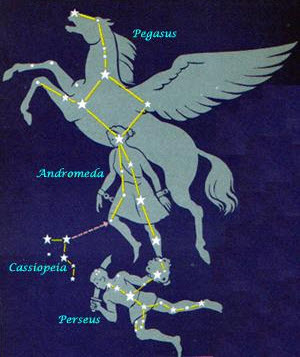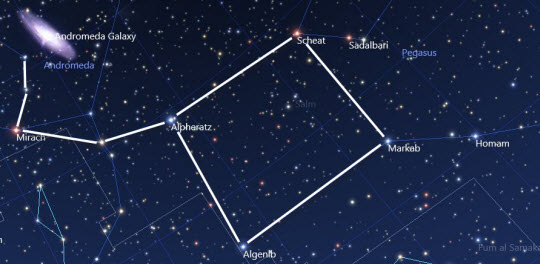The Square
 One of the chief constellations of the autumn night sky is the group of Pegasus. The main body of this constellation, known as the ‘Square of Pegasus’ can be utilised as a ‘signpost’ for locating constellations and leading stars arranged in the south and eastern aspects of the sky.
One of the chief constellations of the autumn night sky is the group of Pegasus. The main body of this constellation, known as the ‘Square of Pegasus’ can be utilised as a ‘signpost’ for locating constellations and leading stars arranged in the south and eastern aspects of the sky.
By following a line diagonally through Alpheratz and Markab (alpha Pegasi) down to the South-East, you are first guided to a zig-zag arrangement of stars representing the water jar, part of the zodiac constellation of Aquarius, the Water Bearer. Continue on this same trajectory to locate Capricornus- the Sea Goat, just above the SSW horizon. By projecting a line down through Markab from Scheat to the SSE horizon, you will drop onto Fomalhaut the most southerly of first magnitude stars (those ranked brightest) visible from Britain. Fomalhaut marks the mouth of Pisces Austrinus- the Southern Fish, the constellation’s northern counterpart; Pisces, occupies a large portion of the sky below Pegasus. A faint circlet of stars directly below the square represent Aphrodite the western fish, whilst the eastern fish; Heros swim below Andromeda. A ribbon of faint stars joins the two.
We now turn from small fry, to the largest sea creature in the heavens; Cetus, the Whale. This constellation may be hunted down by using Alpheratz and Algenib as pointers. Its brightest star, Deneb Kaitos or Diphda, marks the great tail of the creature. Alpha Ceti or Menkar denotes the beasts head, below the stars of Aries. The most celebrated object in Cetus is a variable star called Mira “the wonderful”, an extraordinary pulsating red super giant perhaps 200 million miles in diameter. At maximum, Mira is visible to the naked eye, but requires binoculars or a small scope when at minimum seven months later. Mira lies roughly midway between Menkar and Diphda. See if you can spot it in binoculars.
The ‘square’ asterism also serves as the jumping off point for tracking down our ‘nearby big sister galaxy’, the Andromeda galaxy, see below.
The Andromeda Galaxy
 With moonlight absent during the evenings from the second week in October, why not try to seek out an entirely separate galaxy with just the naked eye. Sound difficult? Well it’s easier than you may think. First find the great Square of Pegasus located a couple of hand spans above the east horizon. Extending eastwards away from Alpheratz, the square’s upper left hand star, a chain of stars mark the main body of Princess Andromeda. Starting from Alpheratz, count two stars along this chain before turning northwards passing two fainter stars. Close by the second of these look for an elongated misty patch of light; the Andromeda Galaxy.
With moonlight absent during the evenings from the second week in October, why not try to seek out an entirely separate galaxy with just the naked eye. Sound difficult? Well it’s easier than you may think. First find the great Square of Pegasus located a couple of hand spans above the east horizon. Extending eastwards away from Alpheratz, the square’s upper left hand star, a chain of stars mark the main body of Princess Andromeda. Starting from Alpheratz, count two stars along this chain before turning northwards passing two fainter stars. Close by the second of these look for an elongated misty patch of light; the Andromeda Galaxy.
At a distance of 2.65 million light years our sister galaxy is considered the most remote object visible to the unaided eye. If skies are dark and transparent it should be relatively easy to identify, but if you are not sure use the “averted vision” technique; i.e. don’t look directly at the object, but to one side, utilizing the more sensitive rod cells of the eye allowing faint nebulous objects to stand out.
The Andromeda galaxy, together with our own Milky Way and another spiral galaxy, the Pinwheel galaxy ( marked on chart - M33) are the three ‘big fish’ in a cluster of galaxies known as the ‘local group’ all gravitationally bound together. The others are small irregular galaxies too faint for the average backyard telescope. In an expanding universe where everything is hurtling away from one another, the Milky Way and the Andromeda galaxy are slowly edging together, a process that will take four to five billion years, merging around the time our Sun reaches the end of its life. So, whether you use the naked eye, binoculars or a telescope to view our ‘near’ galactic neighbour, it is astonishing to reflect that this faint smudge of light emanates from over 300 billion suns arranged in a spiral system spanning some 160,000 light years across. The combined radiance diminished only by a 2.65 million year journey, a journey that started when our early human ancestors first gazed up at the starry firmament.
- Log in to post comments


